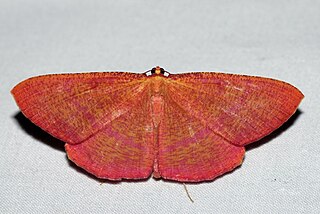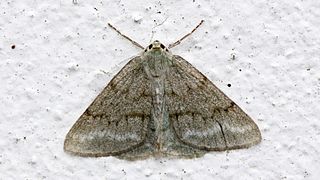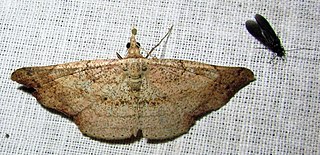
The Drepanidae are a family of moths with about 660 species described worldwide. They are generally divided in three subfamilies, which share the same type of hearing organ. Thyatirinae, previously often placed in their own family, bear a superficial resemblance to Noctuidae. Many species in the drepanid family have a distinctively hook-shaped apex to the fore wing, leading to their common name of hook-tips.

The Siberian grouse, also known as Siberian spruce grouse, Amur grouse, or Asian spruce grouse, is a short, rotund forest-dwelling grouse. A sedentary, non-migratory bird, it is the only member of the genus Falcipennis. The spruce grouse of North America, which physically looks similar, is now placed in the monotypic genus Canachites.

The Limacodidae or Eucleidae are a family of moths in the superfamily Zygaenoidea or the Cossoidea; the placement is in dispute. They are often called slug moths because their caterpillars bear a distinct resemblance to slugs. They are also called cup moths because of the shape of their cocoons.

Callidulidae, the only known family of the superfamily Calliduloidea, is the family of Old World butterfly-moths, containing eight genera. They have a peculiar distribution, restricted to the Old World tropics of Southeast Asia to Australasia and Madagascar. The three subfamilies exhibit both day- and night-flying behaviour.

Cassyma is a genus of moths in the family Geometridae first described by Achille Guenée in 1857. Its species are found primarily in South and Southeast Asia.

Eumelea is a genus of moths in the family Geometridae. It was described by James Duncan and John O. Westwood in 1841. Species are confined to Austro-Malayan subregions and throughout China, India, Sri Lanka and Myanmar.
Mesothisa is a genus of moths in the family Geometridae described by Warren in 1905.

Ozola is a genus of moths in the family Geometridae first described by Francis Walker in 1861.

Sarcinodes is a genus of moths in the family Geometridae erected by Achille Guenée in 1857. The species are large with pinkish, mauvish or brownish-gray body and wings. The wings are traversed by between one and three oblique, straight fasciae. The forewing apex is acute, slightly falcate. The male antennae are unipectinate, those of the female are typically filiform, in some species unipectinate. The species are found in east Asia.

Asthenini is a tribe of geometer moths under subfamily Larentiinae first described by Warren in 1893. The tribe has been combined with Eupitheciini in the past, most notably by Jeremy Daniel Holloway in his work The Moths of Borneo.

Mustilia is a genus of moths of the Endromidae family. The genus was previously placed in the subfamily Prismostictinae of the Bombycidae family.

Dana Reizniece-Ozola is a Latvian politician and chess player. She has been managing director of the International Chess Federation (FIDE) since 2021. She also served as minister of Economics (2014–2016) and minister of Finance (2016–2019) of the Republic of Latvia. Reizniece-Ozola was elected as a member of the 10th, 11th, 12th and 13th Saeima of the Republic of Latvia and worked as the chairperson of the Commission on Education, Culture and Science, Member of the Legal Affairs Commission and Member of the European Affairs Commission. In chess, Reizniece-Ozola was awarded the title of Woman Grandmaster by FIDE in 2001. She is presently vice-president of the European Chess Union.

The Pseudoterpnini are a tribe of geometer moths in the subfamily Geometrinae. The tribe was described by Warren in 1893. It was alternatively treated as subtribe Pseudoterpniti by Jeremy Daniel Holloway in 1996.
Mustilia falcipennis is a moth in the family Endromidae first described by Francis Walker in 1865. It is found in India and Bhutan.
Oenospila kopperi is a moth species in the geometrid genus Oenospila. It is found on Sumatra in montane forests.

Pingasa rubimontana is a moth of the family Geometridae first described by Jeremy Daniel Holloway and Manfred D. Sommerer in 1984. It is found on Sumatra, Borneo and Sulawesi. The habitat consists of upper montane forest, where it is found at elevations between 1,200 and 1,790 meters.
Ozola microniaria is a moth of the family Geometridae first described by Francis Walker in 1862. It is found in Sri Lanka.

Ozola minor is a moth of the family Geometridae first described by Frederic Moore in 1888. It is found in Sri Lanka, India, the Andaman Islands, Sumatra, Borneo, the Philippines and Sulawesi.














